This text was obtained via automated optical character recognition.
It has not been edited and may therefore contain several errors.
that the river, ?...which rises in the Chactaw [sic] nation, and is navigable upwards of 150 miles...In the year 1769, there were some settlements on this river, where raised tobacco, indigo, cotton, rice, Indian corn, and all sorts of vegetables. The land produces a variety of timber fir for pipe and hogshead staves, masts, yards, and all kind of plank for ship building.? He mentions that the land is covered ?with canes, oaks, ash, mulberry, hickory, poplar, cedar and cypress.?xi As far as we know, Jean Favre was the only settler present in the lower reach of the East Pearl River in 1769.
Jean Claude Favre married Marguerite Wiltz (1740-1805) on June 7, 1759 (or 1770 in Mobile American State Papers Volume 1). She was the daughter of Marie Anne Colon (bl 722) and M. Laurent Wiltz. Her sister Marguerite Colon married Joseph Barbeau dit Boisdore, a Canadian on October 13, 1747 (or was this the second marriage for Marguerite Wiltz, widow of Jean Claude Favre). It is interesting to note that, when the Spanish authorities conquered West Florida and began settlements, the Colon and Boisdore31" names appear among the earliest deeds along the East Pearl River1.
Another interesting fact is that Marie Therese Colon, born in 1715 from the marriage of J.B. Colon and M. Marguerite Praux, married Jean Baptiste Allain dit Rouceve (Little Alain), a famous Indian interpreter who would also be granted land along the East Pearl River by the
1 There are a few mentions of Luis Boisdore in early records. He apparently served in the Fourth Company of Fusiliers of the New Orleans militia and lived in the ?rear of the city? in 1770 {Robichaux 1973 ID: 39} Luis may have been a descendant of Joseph who in 1778 is shown as living with his wife on the left side of St. Ursulle St. in New Orleans. At that time Joseph Boisdore and his wife were both over 49 years old, had five slaves, and no occupation listed.
Apparently relations between the Favres and Boisdores were not always cordial. This is seen in a lawsuit brought in 1776 by Luis Boisdore versus Jean Favre in New Orleans over a slave named ?Luison.? This case continued until 1783 when Widow Favre settled with Boisdore. (cf. LHQ October 1928, vol. II, nmo 4: 668; St Louis Cathedral Record of Interments (1793-1803) page 115 Act 1019) )11).
6

Favre The-Favre-Family-in-Hancock-County-06